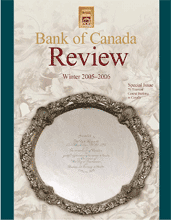Bank of Canada Review - Winter 2005-2006
Available as:
PDF
Cover page
Silver Presentation Salver
The salver, which was bequeathed to the Bank of Canada by Lady Macmillan in 1967, is part of the artifact collection of the Bank of Canada Archives.
Photography by Mone Cheng, Innovacom, Ottawa.
